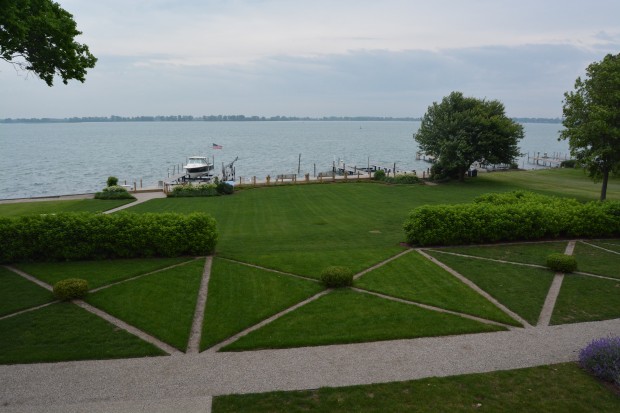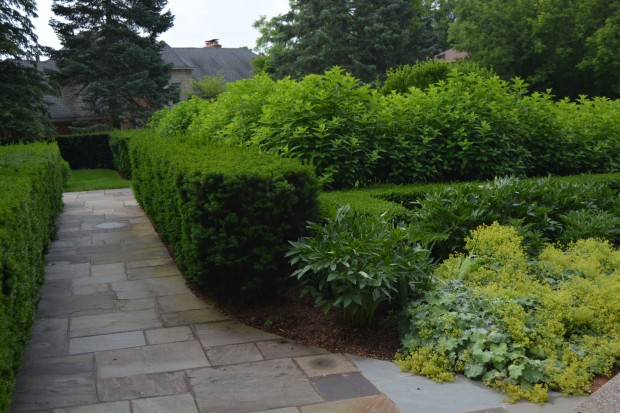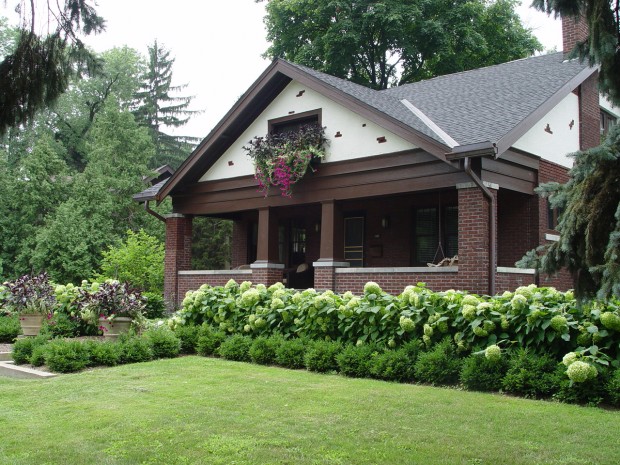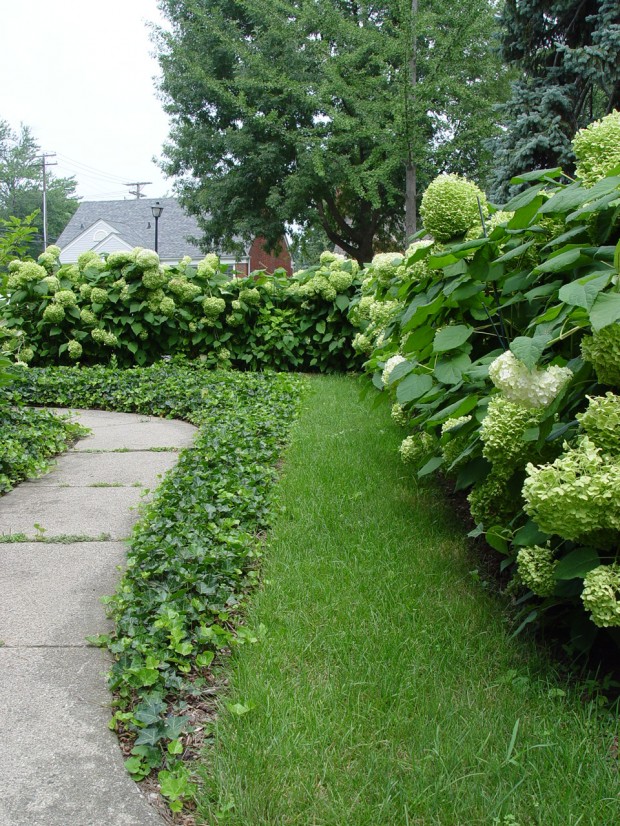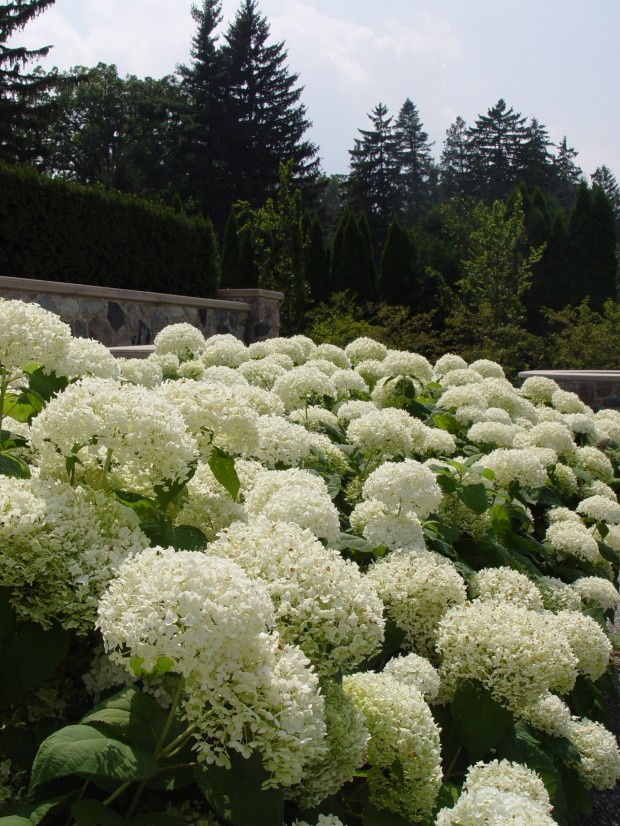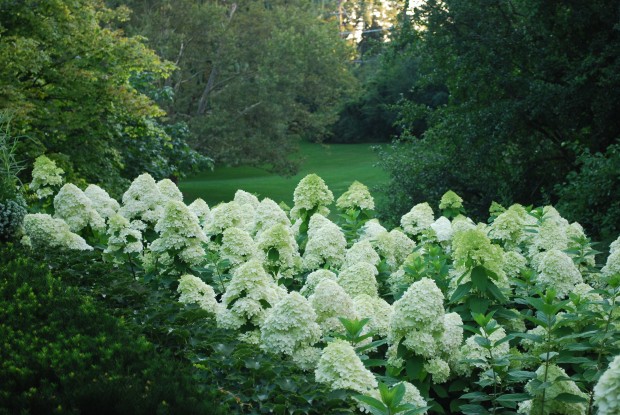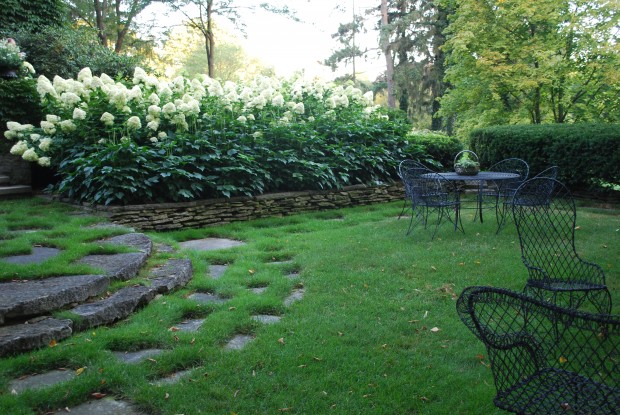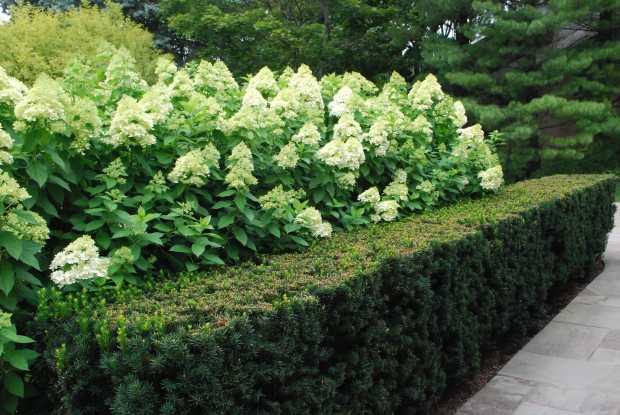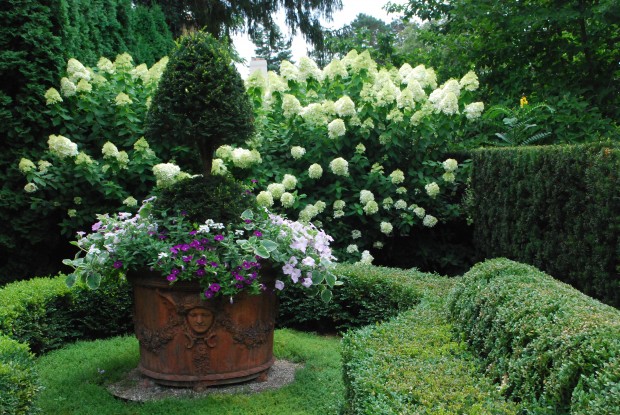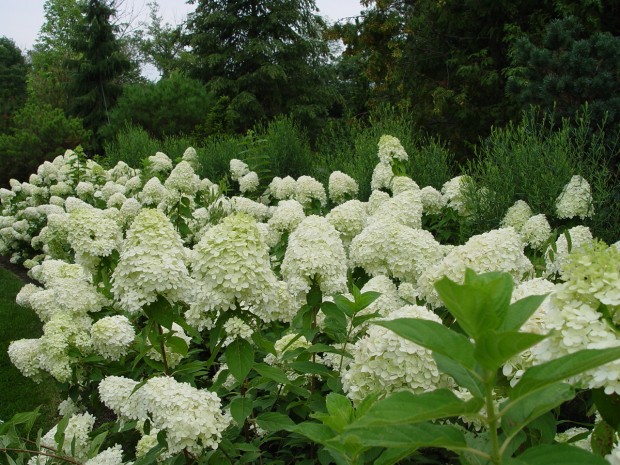 No discussion of a summer landscape in the mid west is complete without a a discussion about hydrangeas. Simply said, a hydrangea is a large leaved blowsy shrub noted for its spectacularly showy flowers. I should preface my remarks about hydrangeas with my point of view about shrubs in general. I am keen for any shrub that can endow a landscape. I find that shrubs perform year after year, with a minimum of maintenance. Some medium sized shrubs-as in spirea-not only tolerate being cut to the ground in the spring, they spring back and bloom without missing a beat. Other shrubs not only tolerate uninformed pruning, they thrive in spite of it. New cultivars of dwarf shrubs-I am thinking dwarf butterfly bush – amiably adapt to small gardens. Big shrubs can screen an untoward view. Shrubs have a decently long life span. They ask little, and provide a lot.
No discussion of a summer landscape in the mid west is complete without a a discussion about hydrangeas. Simply said, a hydrangea is a large leaved blowsy shrub noted for its spectacularly showy flowers. I should preface my remarks about hydrangeas with my point of view about shrubs in general. I am keen for any shrub that can endow a landscape. I find that shrubs perform year after year, with a minimum of maintenance. Some medium sized shrubs-as in spirea-not only tolerate being cut to the ground in the spring, they spring back and bloom without missing a beat. Other shrubs not only tolerate uninformed pruning, they thrive in spite of it. New cultivars of dwarf shrubs-I am thinking dwarf butterfly bush – amiably adapt to small gardens. Big shrubs can screen an untoward view. Shrubs have a decently long life span. They ask little, and provide a lot.
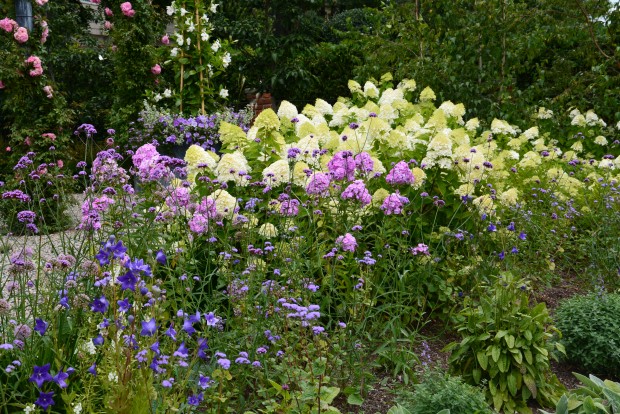 They bridge the gap between the perennials that are below eye level, and the trees that are above eye level. A yearly pruning takes the place of the long list of care requirements that perennials require. Shrubs do take a lot of room, so if you garden is small, be discriminating in your choices. Hydrangeas are as friendly to a perennial garden as they are to a stand of trees. They can add weight to a garden. Lime Light hydrangeas sport greenish white cone shaped flowers that can back up a perennial garden. They have a long season of bloom. Their twigs are sturdily upright.
They bridge the gap between the perennials that are below eye level, and the trees that are above eye level. A yearly pruning takes the place of the long list of care requirements that perennials require. Shrubs do take a lot of room, so if you garden is small, be discriminating in your choices. Hydrangeas are as friendly to a perennial garden as they are to a stand of trees. They can add weight to a garden. Lime Light hydrangeas sport greenish white cone shaped flowers that can back up a perennial garden. They have a long season of bloom. Their twigs are sturdily upright.
 The hydrangea Annabelle has been in bloom since June in my zone. This is a stellar year for them. Everywhere I see them, they are standing up fairly straight, and loaded with blooms. I have never been a big fan of the Annabelles. Their tendency to flop over demands careful staking way in advance of the growing and flowering. What a nuisance. This year, all those giant white blooms look great wherever I see them. Staked, and not staked. In sun, and in shade. I suspect our heavy and regular rain has been really good for them.
The hydrangea Annabelle has been in bloom since June in my zone. This is a stellar year for them. Everywhere I see them, they are standing up fairly straight, and loaded with blooms. I have never been a big fan of the Annabelles. Their tendency to flop over demands careful staking way in advance of the growing and flowering. What a nuisance. This year, all those giant white blooms look great wherever I see them. Staked, and not staked. In sun, and in shade. I suspect our heavy and regular rain has been really good for them.
 I planted 3 rows of annabelles and 2 rows of Lime lights in this garden this spring-so the hydrangea bloom time will be long. 5 rows of hydrangeas is an embarrassment of riches in hydrangeas. The Annabelles, to the left, gracefully drooping over a rustic boulder wall, start blooming in June. The taller and more vertical growing back stop of Lime light hydrangeas begin to bloom in late July. This garden is at least 150 feet from a rear terrace. All of that white will read well from a distance. Unseen in this picture-a perennial garden with a lavish white coat of hydrangeas backing it up.
I planted 3 rows of annabelles and 2 rows of Lime lights in this garden this spring-so the hydrangea bloom time will be long. 5 rows of hydrangeas is an embarrassment of riches in hydrangeas. The Annabelles, to the left, gracefully drooping over a rustic boulder wall, start blooming in June. The taller and more vertical growing back stop of Lime light hydrangeas begin to bloom in late July. This garden is at least 150 feet from a rear terrace. All of that white will read well from a distance. Unseen in this picture-a perennial garden with a lavish white coat of hydrangeas backing it up.
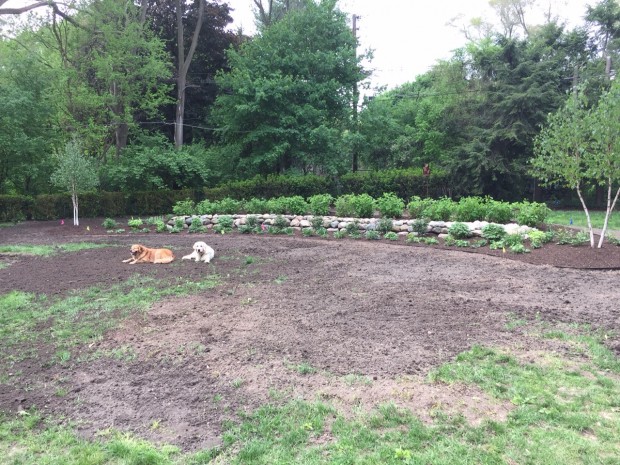 I placed the 3 rows of Annabelle hydrangeas just behind this rock wall. Their inclination to droop will soften this wall. They will provide a graceful and warm backdrop to the perennials in front of the wall. The Limelights in the rear were invisible when they were planted. But by next year they will provide another taller layer of white to the perennial garden.
I placed the 3 rows of Annabelle hydrangeas just behind this rock wall. Their inclination to droop will soften this wall. They will provide a graceful and warm backdrop to the perennials in front of the wall. The Limelights in the rear were invisible when they were planted. But by next year they will provide another taller layer of white to the perennial garden.
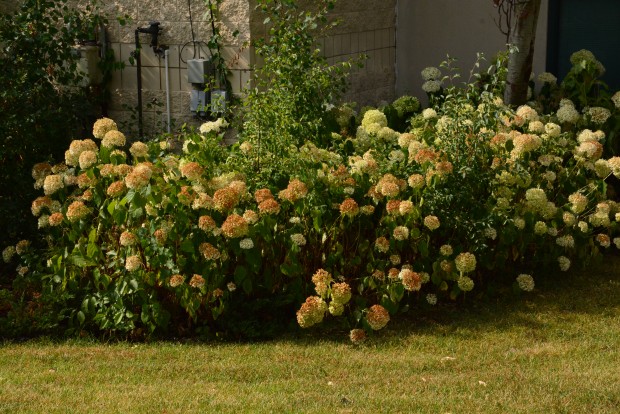 Hydrangeas do not like dry soil. These Annabelles are in sore need of water. They may flower, but the flowers will burn without regular irrigation. If your hydrangeas have leaves that are turning yellow and dropping on the interior, get out the hose and soak them.
Hydrangeas do not like dry soil. These Annabelles are in sore need of water. They may flower, but the flowers will burn without regular irrigation. If your hydrangeas have leaves that are turning yellow and dropping on the interior, get out the hose and soak them.
 I also grow Little Lime hydrangeas, which top out at 4-5 feet, and the shortest of the Limelight series-Bobo. At 30 inches tall, they are perfect for a small garden. Or for a foreground garden that needs to be low. They are a good choice for those moments in the landscape that asks for a plant that is short and wide. This hydrangea takes to perennial neighbors like a duck to water. The white flowers highlight and set off all of the other colors in a garden.
I also grow Little Lime hydrangeas, which top out at 4-5 feet, and the shortest of the Limelight series-Bobo. At 30 inches tall, they are perfect for a small garden. Or for a foreground garden that needs to be low. They are a good choice for those moments in the landscape that asks for a plant that is short and wide. This hydrangea takes to perennial neighbors like a duck to water. The white flowers highlight and set off all of the other colors in a garden.
 I prune my Lime lights in April. I wait until I see the buds swelling. I usually prune my 50 plants back to 30″ tall – give or take. Every other year. I do not prune them down near the ground. Really hard pruning results in fewer, and bigger flowers. I am not interested in bigger flowers. I like lots of medium sized flowers. I like my Lime Lights at home very tall-they are faced down by an old hedge of Hicks yews. Some years I snip the old flower heads off, and leave them be. Light pruning means you will get long woody legs. The following year, I may take them down to 30″ My yews cover those old legs. If your hydrangeas are front and center, take them down closer to 30″. Irregularly. Prune each branch individually, so every branch has its own air and light space. You can prune down to 14″ above ground-if you dare. Do not go lower than this. Forcing growth from below ground is hard on a shrub.
I prune my Lime lights in April. I wait until I see the buds swelling. I usually prune my 50 plants back to 30″ tall – give or take. Every other year. I do not prune them down near the ground. Really hard pruning results in fewer, and bigger flowers. I am not interested in bigger flowers. I like lots of medium sized flowers. I like my Lime Lights at home very tall-they are faced down by an old hedge of Hicks yews. Some years I snip the old flower heads off, and leave them be. Light pruning means you will get long woody legs. The following year, I may take them down to 30″ My yews cover those old legs. If your hydrangeas are front and center, take them down closer to 30″. Irregularly. Prune each branch individually, so every branch has its own air and light space. You can prune down to 14″ above ground-if you dare. Do not go lower than this. Forcing growth from below ground is hard on a shrub.
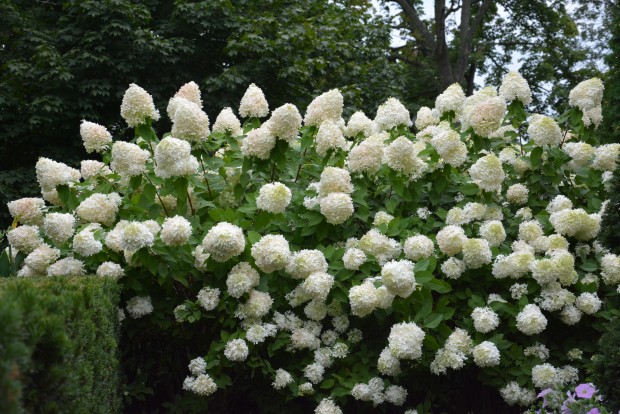 I have had a lot of questions regarding the proper spacing of Lime Light hydrangeas. I would say there is no proper, or right spacing. The spacing chosen has to do with the design intent. I space them at 30″or 36″ on center, if my intent is to create a dense and homogeneous hedge. Close spacing means that the entire length and width of the hedge grows and prospers as one organism. The individual plants intertwine, and become one. I have never seen a hydrangea hedge that resented this spacing. A spacing at 6 feet is an option. But this row will never read as a hedge. It will read as thick and thin. Wavy. I have had clients space them at 6 feet one year, and add an intervening plant the next year.
I have had a lot of questions regarding the proper spacing of Lime Light hydrangeas. I would say there is no proper, or right spacing. The spacing chosen has to do with the design intent. I space them at 30″or 36″ on center, if my intent is to create a dense and homogeneous hedge. Close spacing means that the entire length and width of the hedge grows and prospers as one organism. The individual plants intertwine, and become one. I have never seen a hydrangea hedge that resented this spacing. A spacing at 6 feet is an option. But this row will never read as a hedge. It will read as thick and thin. Wavy. I have had clients space them at 6 feet one year, and add an intervening plant the next year.
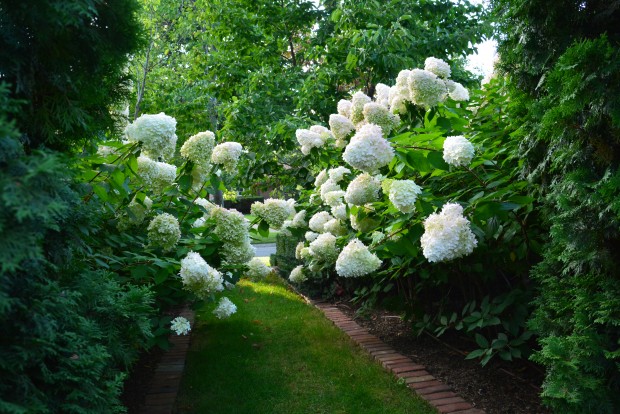 Hedging hydrangeas make a very strong statement. A lone hydrangea as a foundation planting always looks alone, and gawky. Great landscapes gracefully integrate individual plants in service of a greater whole. I like to mass hydrangeas. A showy shrub such as this-plant lots of them. Build your gardens around them. Be generous.
Hedging hydrangeas make a very strong statement. A lone hydrangea as a foundation planting always looks alone, and gawky. Great landscapes gracefully integrate individual plants in service of a greater whole. I like to mass hydrangeas. A showy shrub such as this-plant lots of them. Build your gardens around them. Be generous.
 In late September, the Lime Light blooms will begin to pink up. This color is a sign that the season is coming to a close.
In late September, the Lime Light blooms will begin to pink up. This color is a sign that the season is coming to a close.
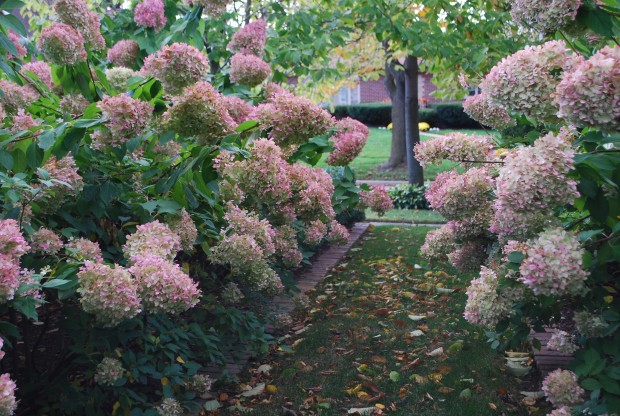 In October, the pink deepens. This view out from my rose garden is a view I treasure from July through October. The dry flower heads stay put all winter long. The list of plants that do well in my zone is long, and varied. The delight this shrub furnishes to me is very long and varied. I would not do without them – the hydrangeas.
In October, the pink deepens. This view out from my rose garden is a view I treasure from July through October. The dry flower heads stay put all winter long. The list of plants that do well in my zone is long, and varied. The delight this shrub furnishes to me is very long and varied. I would not do without them – the hydrangeas.
